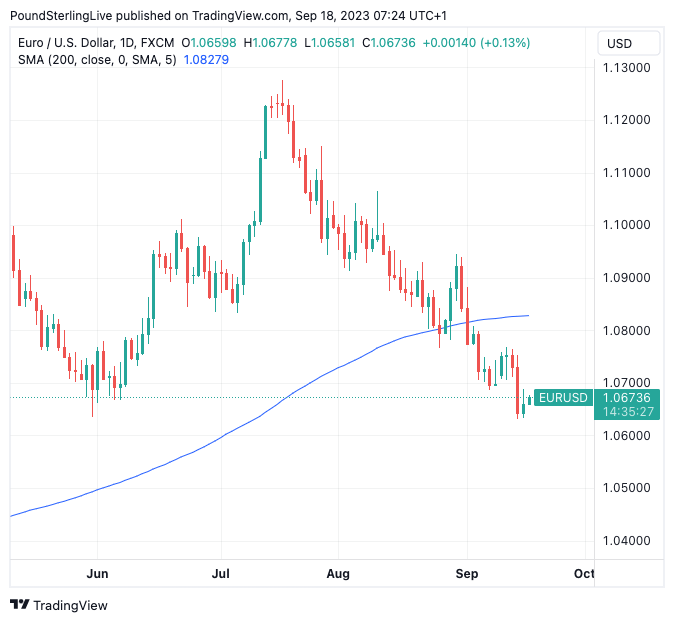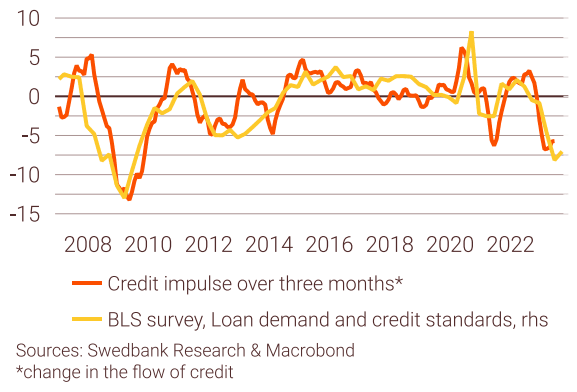EUR/USD Week Ahead Forecast: Pressured, But Fed Can Offer Some Relief
- Written by: Gary Howes
-
- EURUSD trend is bearish, Eurozone calendar empty
- Putting Federal Reserve in focus midweek
- A downshift in the 'dot plot' could offer EURUSD relief

Image © Adobe Images
The Euro looks set to remain under pressure against the Dollar over a multi-week basis now that it has broken below a key level on the charts, but in a week devoid of Eurozone data Wednesday's U.S. Federal Reserve decision could offer the single currency some relief.
The Euro to Dollar exchange rate (EURUSD) saw downside momentum build following the European Central Bank's latest interest rate decision which was accompanied by guidance that rates would be maintained at current levels for some time, thereby ultimately signalling a pause to the hiking cycle.
Euro-Dollar has subsequently held onto its ECB‑inspired losses and is currently trading near 1.0675, the weakest since March 2023.
"While the euro initially attempted to stage a rally after the ECB decided to hike rates by 25bps and hit a high of 1.0729, those initial gains proved short-lived," says Lee Hardman, a foreign exchange analyst at MUFG Bank Ltd. "It opens the door to a test of the bottom of the current year-to-date trading range between 1.0500 and 1.1000."
"The ECB delivered a 'dovish' 25bp hike... signalling policy interest rates have peaked. Indeed, we expect the next move from the ECB will be a rate cut in April 2024," says Carol Kong, a foreign exchange strategist at Commonwealth Bank.
By comparison, money markets are priced for about 11bp of further ECB tightening and the first 25bp rate cut in July 2024, suggesting further downside pressure for the exchange rate if Commonwealth's view proves correct and a further dovish repricing occurs.
The only real interest on the Eurozone calendar this week are ECB Governing Council member speeches and we have already heard from the head of the Slovakian central bank, Peter Kazimir, who said Monday that the ECB rate hike could be the final one in this cycle, even if he did not rule out the possibility of others.
François Villeroy - of France's central bank - said the key interest rate will remain at 4% for as long as necessary.
Ongoing weakness in the Euro-Dollar pair has meant the trend has shifted in favour of the Dollar after a move below the 200-day average on the daily charts, "which looks ominous," says Kit Juckes, an analyst at Société Générale. "Even someone as untechnical as me can see the significance of the 200-day average here."
Above: EURUSD has broken below the 200-day moving average, which advocates for ongoing weakness.
"We expect the incoming economic data to weaken and ultimately indicate a recession in the Eurozone because of very restrictive interest rates. The weakening prospect of the Eurozone economy will be a headwind for EUR in our view," says Kong.
Juckes at Soc Gen meanwhile says the Euro can remain under pressure until the Eurozone's growth impulse improves.
"The only positive I can think of for the euro or sterling, in a world where growth expectations are the biggest driver of exchange rates, is that expectations about UK and Eurozone growth are already dire relative to the US. That ought to be enough to prevent a sharp collapse by EUR/USD or GBP/USD (parity for EUR/USD, or GBP/USD down to around 1.15 seem unlikely) but GBP/USD could get to 1.20, and EUR/USD can easily trade below 1.05 easily if we don’t get any positive surprises from the real economy data in Europe soon," he explains.
Image courtesy of Swedbank.
Federal Reserve: Dot Plot A Downside Risk to USD
Wednesday sees the Federal Reserve give its latest decisions and guidance, offering some potential volatility in the U.S. Dollar, but a fundamental trend-turning decision is unlikely.
"On balance we think that the data released in the interim between meetings supports our view that the U.S. central bank will maintain the Federal funds rate at 5.25-5.50% next Wednesday at 19:00 BST, matching both other economists and market expectations," says Ellie Henderson, an economist at Investec.
The Fed's updated set of economic projections will be watched in the form of the latest 'dot plot' chart, which anonymously sets out where FOMC members think rates are heading.
"From various comments, even from those on the more hawkish side of the spectrum, we would expect more members to shift their end-2023 dots towards the current level of rates, signalling that we are indeed at the peak," says Henderson.
"If we are correct, then this is likely to be one of the few concrete giveaways from the Fed that we could already be at peak rates," she adds.
Downside risks to the Dollar would involve some members of the Fed signalling the prospect of rate cuts in 2024.
Above: FOMC dot plot (Jun 2023). Source: Federal Reserve, Macrobond, ANZ Research. Image courtesy of ANZ.
Investec says the Fed's summer scorecard will reveal two very close-to-consensus CPI inflation reports, a sizeable upside surprise to the latest unemployment rate number, offsetting the marginally below-expectation July print and a significantly below-consensus PMI report.
"This is just a selection of the data that the Fed has to digest, but in all the current environment appears to be one of falling core inflation (headline CPI inflation has been propped up be higher fuel costs), a loosening in labour market conditions and a cooling in overall economic momentum. Against such a backdrop the current level of rates is probably appropriate to help guide inflation back to target," says Henderson.








